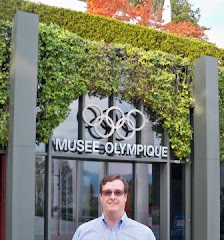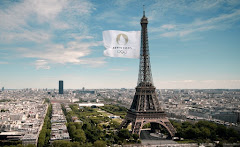Just one line of
an October news article inspired a February jaunt to Amsterdam.
"Vermeer retrospective to be held in 2023 at the Rijksmuseum" was all it took.
In recent years (though we could not pinpoint exactly when), a close friend, his wife and I began an informal competition, each vying for the title of s/he "who has seen the most Vermeer paintings."
With a reported "record number" (28) of the artist's canvases under one roof, it made sense to go Dutch post-haste, not only for the sake of advancement in our playful contest but also for the joy brought with each Vermeer viewing.
Of the artist's 37 known works (down to 36 if one discounts a canvas still
missing from a 1990 burglary, reduced further to 35 given
recent study), each of us had experienced some of the "easy access" Vermeer portraits on view at the National Gallery in Washington, in the Manhattan-based galleries of The Met and neighboring
Frick Collection, or in The Louvre, while neither of us yet journeyed to the more elusive Vermeer paintings further afield in museums of Germany, Ireland and Tokyo. The exhibition also promised, and delivered, a look at some works held in private collections.
My own introduction to Vermeer was through client publicity work when "The Girl with the Pearl Earring" made its world tour
summer stop at Atlanta's High Museum of Art in 2013. It was love at first uncrating, setting in motion my quest to experience her siblings.
Landing at Schipol was characteristically easy, and after short rail rides by train to Centraal and tram to the Leonardo Hotel, which faces the same canal as Rijksmuseum, it was just a short stroll to engage with Vermeer's masterpieces. In fact, the public transport commute was shorter than the three-hour exploration of the special galleries.
With some intention, it's now my habit (when museum security does not intervene) to first walk through art exhibitions in reverse, starting at the exit and slowly studying each work sans mobile phone and without reading wall texts. It's all about the art and just the works, not the organizer's narrative nor "expert" perspectives, though often there are informative notes to absorb during the second pass.
Since most special exhibitions of late have a gift shop near the end, crossing this retail space usually teases the "must see" and "nice to see" highlights arranged by the curators. This proved especially true with Vermeer's retail opportunities, including a Rijksmuseum-specific batch of Playmobil sets.
I learned Vermeer painted from the mid-1650s to 1672, sometimes investing two or three years on one creation, and occasionally working on more than one painting simultaneously. Paraphrasing Rijksmuseum General Director Taco Dibbits' foreword to the exhibition catalogue, 'Closer to Vermeer' could be the exhibition's motto, which rings true in than I got my face right up within a half-meter of almost everything hanging on the dark blue or taupe walls.
The first visual feast was "Woman with a Pearl Necklace" in town from Berlin, one of four or five Vermeers in which his model dons a yellow fur with what may be snow leopard cuffs and collars.
Not far from her, "The Geographer" which travelled from Frankfurt, gazed out the artist's studio window that graces the left side in many other works.
The galleries did not seem overcrowded from my 7 p.m. entry to closing time at 10. More than once I overheard English speaking guests referencing the outstanding Penn & Teller feature documentary film "
Tim's Vermeer" regarding a businessman who invested in study of the artist's technique. Other languages overheard include Dutch, French, Mandarin, Japanese, Spanish or Portuguese and at least one indecipherable conversation from Eastern Europe (possibly Russian or Polish).
With an exception or two, each gallery included five-to-seven works, with Vermeer's two known hometown street or landscapes, assorted character study tronies and more monumental works generally grouped together.
While I spent about five to seven minutes with each work -- about 2.5 hours plus a Nescafe/waffle break and exit through the gift shop -- certain canvases really popped or resonated:
From Tokyo's National Museum of Western Art, "Saint Praxedis" was entirely new to me and one of the boldest surprises, not only for its subject's vivid rouge attire but also the drama -- a decapitated martyr and another woman approaching his corpse -- looming in the background. The squeezing of blood from her foreground cloth or sponge into an elaborate urn is reminiscent of another fluid-spilling work displayed around the corner (and painted three years later), "The Milkmaid" in a temporary new space of her home museum.
"Girl Reading a Letter at an Open Window" in town from Dresden. This canvas enjoyed a bit of its own, well-deserved
international press in recent years for the museum discovery and restoration of a painted-over Cupid portrait aloft in the artist's studio.
"Young Woman Standing at a Virginal" which had fellow attendees or docents and me pointing out "there's that Cupid again." The youthful musician breaks the fourth wall with a sly smirk while fingering the instrument's keys, as if to state, "Here's another ditty from Delft!"
"Girl Interrupted at Her Music" with another Vermeer model breaking the fourth wall, this time with less mirth and more of a melancholic or
j'accuse! gaze. This painting inspired the title and themes of the early 1990s
memoir and later
film starring Winona Ryder, Angelina Jolie and Elisabeth Moss. This was my second encounter, a follow up to a
2015 intro at The Frick.
"The Glass of Wine" featuring a young woman polishing off a serving of vino while a Dutchman motions as though to refill her glass. My eyes kept shifting to the brightly backlit stained-glass window, which I later learned depicts Temperance.
But the pièce de résistance painting that brought a tear of joy was another new-to-me Vermeer titled "The Procuress" featuring a mix of favorite elements framed by the artist elsewhere.
The tapestry, for instance, is so detailed you could almost count individual threads. Or the light reflecting from the Dutch porcelain, drinking glass and hand-held guilder also pops delicately from the grin of Vermeer's self-portrait (far left). This canvas made me beam from ear to ear -- I would happily book future passage to experience it again in its Dresden museum home.
Of course, it was fun to reacquaint with "Girl with a Pearl Earring" after all these years (paraphrasing Bobby Brown's late 80s single, "my heart belongs to this tronie"), and also to again experience The Frick's "Officer and Laughing Girl" which, like "The Astronomer" in Paris (regrettably absent for unknown Louvre reasons) is a longtime favorite.
Observation of "The Love Letter" from the Rijksmuseum collection inspired remarks to a friendly museum guard in that the paper missive might instead be handed over from a neighbor imploring the featured young musician to "put down that lute!"
The same guard explained that for the Vermeer exhibition -- which sold out tens of thousands* of tickets during the early days of availability -- the museum assigned about one guard per canvas, perhaps in response to recent protest-centered vandalism that literally brought ruin within only a glass pane's width of a Vermeer in The Hague (a dreadfully misguided and overly risky PR stunt I and other professional communicators have deplored via direct messages to the protesters' media counsel).
* I was not yet able to verify numbers, but another guard estimated "over 200,000" tickets including thousands of stretch timeslots added in response to overwhelming demand.
Though my ticket purchase went through with ease on Feb. 4, a day or two after my friend's wife purchased her passage to Holland for mid-March, within a few days of their on-sale and the opening week blitzkrieg of publicity for the show, the museum website now states "The Vermeer exhibition is definitively sold out" with a link provided to view the entire experience virtually.
Here's hoping those who secured tickets enjoy the experience as much as I did through my reverse-course, the start-to-finish sequence and back again to gather photos for this post.
The race to discover the next and remaining, unseen Vermeers ... is on!
Since my special exhibition ticket was for an after-hours Saturday evening, the press office at Rijksmuseum was kind enough to help me purchase a media ticket to view the main collection the next day.
While I will eventually craft a separate post about Rijksmuseum's outstanding treasures, as noted in the headline to this Vermeer summary, a five-ringed discovery was revealed in close proximity to the special exhibition galleries.
Peering in on Suday, around the corner from the Vermeer entrance, signage prompted a peek inside an Asian Collection gallery in which one of the museum's newest acquisitions -- a donated assemblage of Japanese prints spanning several decades -- yielded a gorgeous platform diving image that, according to the wall text, was a color woodblock print by Onchi Koshiro.
"According to collector Elise Wessels, this is one of the most beautiful prints in the donation ... Onchi made it for the exhibition at the Los Angeles Museum of History, Science and Art organized for the 1932 Summer Olympics."
Bravo, Koshiro!
Photos by Nicholas Wolaver













.jpg)



















